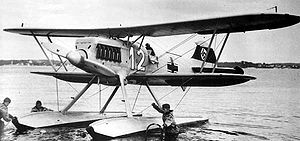Heinkel He 51
| Heinkel He 51 | |
|---|---|
 |
|
| He 51W seaplane | |
| Role | Biplane Fighter Fighter-bomber |
| Manufacturer | Heinkel |
| First flight | May 1933 |
| Introduction | 1935 |
| Retired | 1939 (Luftwaffe) 1952 (Spanish Air Force) |
| Status | Retired |
| Primary user | Luftwaffe |
| Number built | 700 |
The Heinkel He 51 was a German single-seat biplane which was produced in a number of different versions. It was initially developed as a fighter, and a seaplane variant and a ground-attack version were also developed. It was a development of the earlier He 49.
In 1931, Heinkel recruited the talented aircraft designers, Walter and Siegfried Günter, and their first major design for Heinkel was the Heinkel He 49. While this was officially an advanced trainer, in fact it was a fighter. The first prototype, the He 49a, flew in November 1932, and was followed by two further prototypes, the He 49b, with a longer fuselage, and the He 49c, with a revised engine.
The type was ordered into production for the still secret Luftwaffe as the He 51, the first pre-production aircraft flying in May 1933. Deliveries started in July of the next year.
The He 51 was a conventional single-bay biplane, with all-metal construction and fabric covering. It was powered by a glycol-cooled BMW VI engine, with an armament of two 7,92 mm (.323 in) machine guns mounted above the engine.
The He 51 was intended to replace the earlier Arado Ar 65, but served side-by-side with the slightly later Ar 68. The He 51 was outdated the day it entered service, and after an initial run of 150 production fighters, the design was switched into the modified He 51B, with approximately 450 built, including about 46 He 51B-2 floatplanes, and then finally a further 100 He 51C light ground-attack plane.
On 6 August 1936, six of the He 51s were delivered to Spain to fight in the Spanish Civil War along with the fraction of the army in revolt. Initial operations were successful, with the Heinkels meeting and defeating a number of older biplanes of the Spanish Republican Air Force, with two Nieuport Ni-52 fighters, a Breguet 19 and a Potez 54 destroyed on 18 August 1936, the first day of operations by Spanish-flown He 51s. Deliveries continued as the hostilities increased, with two Nationalist squadrons equipped by November, and the Legion Condor forming three squadrons of 12 aircraft each manned by German "volunteers".
...
Wikipedia
